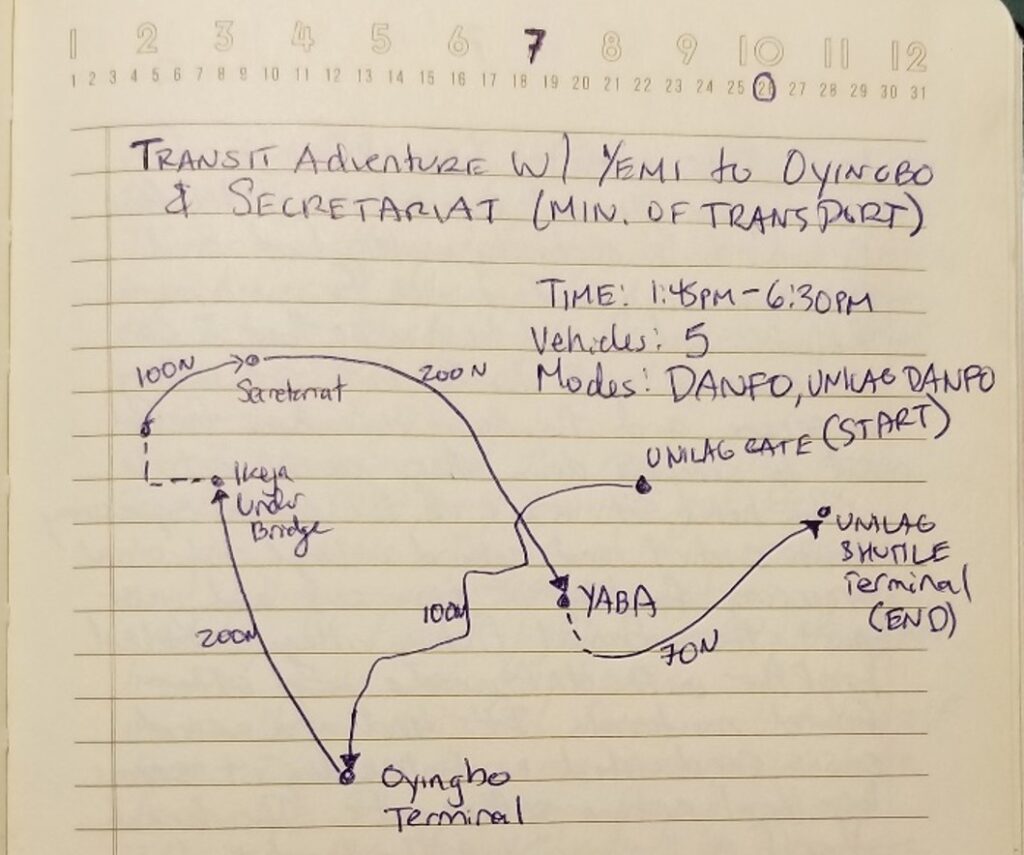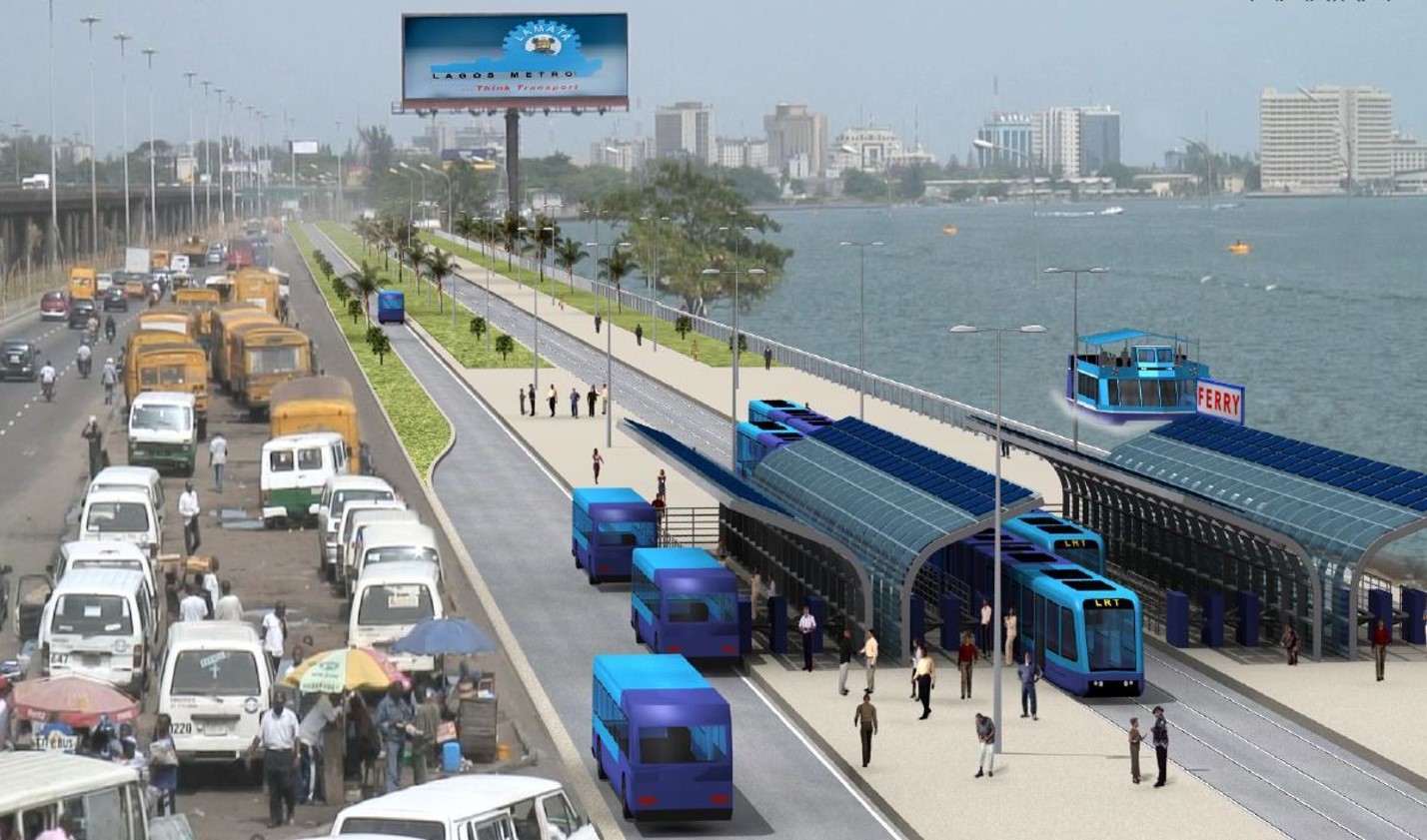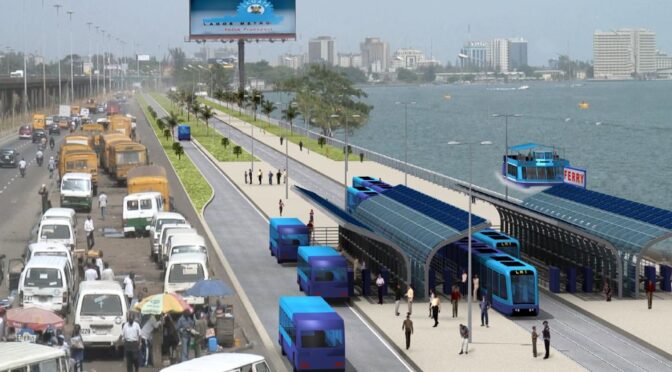Two Sides of Jugaad in the Context of Informal Transit in Lagos, Nigeria
By Louis Alcorn
Introduction
Historically, structurally inefficient formal public transportation has struggled to provide adequate passenger transport in Lagos. Individual private operators have seized the opportunity to fill this void with informal jitney operations, and most of the 23-million Lagosians now rely on informal, minimally-regulated minibus services called danfos. However, navigating the danfo system is not easy (see Figure 1). Danfo drivers consider a suite of anecdotal local knowledge to weave a path from origin to destination that best avoids traffic jams, police checkpoints, and agberos, the informal tax collectors employed by the mafia-esque organization that oversees the informal transport system. As a result of these unpredictable road and traffic conditions, the route that the driver takes may change each trip.

Now, innovative start-ups have begun to experiment with ways to address the public transportation problem with new technologies. With the successful implementation of Uber and Taxify as alternatives to the taxi industry in Lagos, hopes are high for other similar services to revolutionize other modes of transport. Enter lara.ng, a data-lite app that is designed to simplify navigation within the complex danfo network. Users ask a bot (Lara) for directions and Lara will respond within seconds with proposed route(s), transfer locations, and expected bus fares (see Figure 1).

Analysis
Lara.ng and the system it helps users access are both concrete manifestations of the concept of jugaad, a colloquial Hindi word that refers to grassroots innovations or making-do with the materials at hand (Prabhu & Jain, 2015). While Lara.ng represents a positive manifestation of this concept, the operations of the danfo system itself displays the dark, exploitative side of jugaad. Institutional corruption forces danfo drivers to be creative in their daily quest to maximize profits, applying jugaad and tacit knowledge to improvise routes and keep their vehicles running by any means necessary. The way jugaad works may result in an “aesthetic of chaos” (Rem Koolhaas qtd. in Agbiboa, 2016) to an outsider, but it has real impacts on the actors embedded in this system: for example, 99 percent of informal transit workers suffer from hypertension (Akoni, 2013).
Western planning literature and epistemologies advocate institutional or structural solutions to the ills created by the informal system: inefficiency, lack of accountability, traffic congestion, and safety concerns (e.g. Cervero & Golub, 2007). Government agencies in Lagos focus heavily on promoting the incremental eradication of the danfo system (see Figure 3) through the roll-out of the Bus Reform Initiative and the broader Strategic Transport Master Plan. Kamete (2013b, p. 17) might refer to these changes as a “fetish about formality that is fueled by an obsession with urban modernity” that dictates that formal order cannot possibly “coexist with the ‘disorder’ and spatial ‘unruliness’ of informality”. However, Lara.ng pushes back on this narrative, providing accessible means to navigate the city using both formal and informal modes simultaneously. Despite previous attempts to “normalize” the industry by design (see Figure 3) and through “regulation and criminalization” (Kamete, 2013a, p. 641), the flexible resilience of the danfo system has prevailed as an important component of the overall transportation system.

Notwithstanding the numerous shortcomings of the danfo system embedded in the institutional and structural discourses of informality, Lara.ng provides a digital framework to access what serves as the only transportation option for many Lagosians. While most indicate that the danfo system is not optimal, Lara.ng employs jugaad to make the best of transportation resources at hand.
Implications
In place of the digital infrastructure that allows one to navigate transit systems elsewhere in the world using Google Maps, Lara.ng leverages the concept of “people as infrastructure” (Simone, 2004, p. 407) – collaborative social networks that develop as a response to lack of formal physical infrastructure and services – to fill this knowledge gap. In this way, the app offers a portal to connect the individual users to space and each other through the complex assemblage that is the danfo system. The informal transit system and the knowledge required to navigate it simultaneously develop “as a dynamic tension between rhizomic practices of everyday life and hierarchical systems of spatial control” (Dovey, 2012, p. 358). The hierarchical organization of the formal transit system in both management and design (see Figure 3 ) clash with the dynamic and horizontally-structured modus operandi of danfo operations. This friction forces the informal transit system to be incredibly adaptive and unpredictable, artfully negotiating spaces (with bribes) while strategically determining which laws can be tactfully transgressed. The “incessantly flexible, mobile, and provisional” nature of this system and the “interactions of residents that operate” (Simone, 2004, p. 407) within it require an equally adaptive tool to navigate it.
Prabhu and Jain (2015) define jugaad as containing three prongs: frugality, flexibility, and inclusiveness. Frugality in the case of the informal transit system’s operations is predicated by labor precarity and institutional corruption, while frugality in the context of Lara.ng comes from its recognition of the extreme cost concerns of their target audience. Lara.ng functions as a free in-browser app and requires no downloads and minimal data usage. Paralleling the flexible nature of the informal transit system itself, Lara.ng is continuously updated with crowdsourced information to leverage co-produced and collaborative societal knowledge (Simone, 2004). Lastly, Lara.ng is designed to be inclusive and accessible to all. Though penetration rates of mobile phones exceed 80% in urban Lagos, this type of digital infrastructure is still not truly accessible to all—illiterate, non-English-speaking, and poor populations would likely not be able to use such a platform. Still, the developers have endeavored to make it as inclusive as possible, keeping in mind their highly price-sensitive target users. Unlike most other development in the Lagos transportation space, Lara.ng does not attempt to revolutionize the system to generate profit.
Overall, jugaad presents itself in two distinct forms: 1) in a dark, exploitative format relating to the organizational structure of the informal transit system itself, and 2) in a true example of pure, positive jugaad, Lara.ng strives to make the best of a complicated issue with the materials at hand. Furthermore, Lara.ng serves as a digital extension of Simone’s (2004) method of viewing the megacity as a collection of shifting connections, flows, and networks. To this extent, the emergence of such user-driven platforms elucidates a new dimension of this train of thought which he may not have anticipated.
